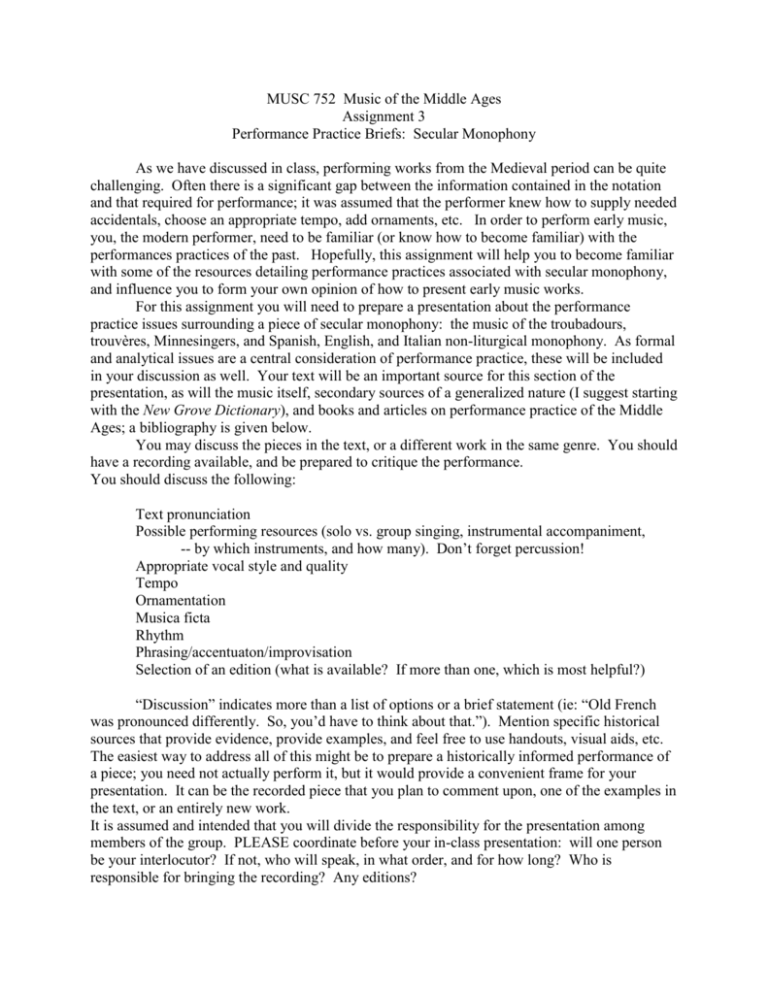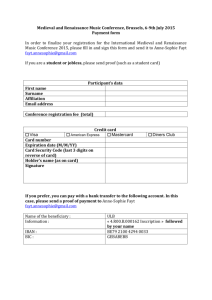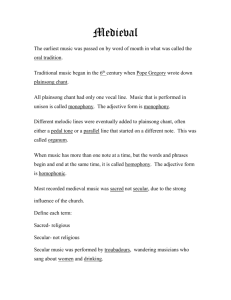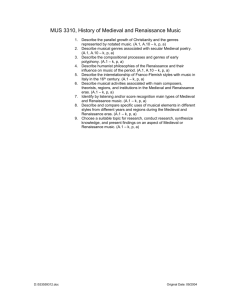MUSC 340 Music History II
advertisement

MUSC 752 Music of the Middle Ages Assignment 3 Performance Practice Briefs: Secular Monophony As we have discussed in class, performing works from the Medieval period can be quite challenging. Often there is a significant gap between the information contained in the notation and that required for performance; it was assumed that the performer knew how to supply needed accidentals, choose an appropriate tempo, add ornaments, etc. In order to perform early music, you, the modern performer, need to be familiar (or know how to become familiar) with the performances practices of the past. Hopefully, this assignment will help you to become familiar with some of the resources detailing performance practices associated with secular monophony, and influence you to form your own opinion of how to present early music works. For this assignment you will need to prepare a presentation about the performance practice issues surrounding a piece of secular monophony: the music of the troubadours, trouvères, Minnesingers, and Spanish, English, and Italian non-liturgical monophony. As formal and analytical issues are a central consideration of performance practice, these will be included in your discussion as well. Your text will be an important source for this section of the presentation, as will the music itself, secondary sources of a generalized nature (I suggest starting with the New Grove Dictionary), and books and articles on performance practice of the Middle Ages; a bibliography is given below. You may discuss the pieces in the text, or a different work in the same genre. You should have a recording available, and be prepared to critique the performance. You should discuss the following: Text pronunciation Possible performing resources (solo vs. group singing, instrumental accompaniment, -- by which instruments, and how many). Don’t forget percussion! Appropriate vocal style and quality Tempo Ornamentation Musica ficta Rhythm Phrasing/accentuaton/improvisation Selection of an edition (what is available? If more than one, which is most helpful?) “Discussion” indicates more than a list of options or a brief statement (ie: “Old French was pronounced differently. So, you’d have to think about that.”). Mention specific historical sources that provide evidence, provide examples, and feel free to use handouts, visual aids, etc. The easiest way to address all of this might be to prepare a historically informed performance of a piece; you need not actually perform it, but it would provide a convenient frame for your presentation. It can be the recorded piece that you plan to comment upon, one of the examples in the text, or an entirely new work. It is assumed and intended that you will divide the responsibility for the presentation among members of the group. PLEASE coordinate before your in-class presentation: will one person be your interlocutor? If not, who will speak, in what order, and for how long? Who is responsible for bringing the recording? Any editions? The following books will be on reserve in the library for your use, and will provide most of the information you need. Feel free, however, to use any other texts or articles that are relevant to your topic. Brown, Howard Mayer et at. “Performing Practice,” in The New Grove Dictionary of Music and Musicians, 2d ed. London: Macmillan, 2001. *Duffin, Ross W., ed. A Performer’s Guide to Medieval Music. Bloomington: Indiana University Press, 2000. *McGee, Timothy. Medieval and Renaissance Music: A Performer’s Guide. Toronto: University of Toronto Press, 1985. ______, with A. G. Rigg and David H. Klausner. Singing Early Music: The Pronunciation of European Languages in the Late Middle Ages and Renaissance. Bloomington, IN: Indiana University Press, 1996. Phillips, Elizabeth V., and John-Paul Christopher Jackson. Performing Medieval and Renaissance Music: an Introductory Guide. NY: Schirmer Books, 1986. Performance Practice Encyclopedia – electronic resource, accessible through on-line library Catalogue Please see me with any questions.









